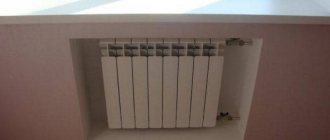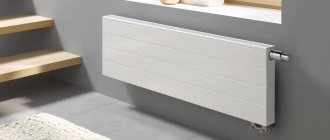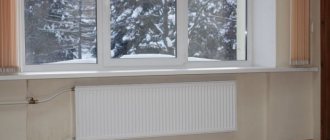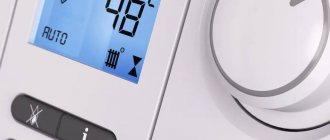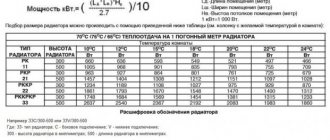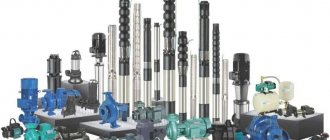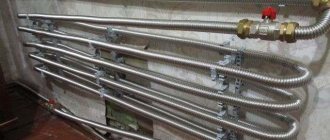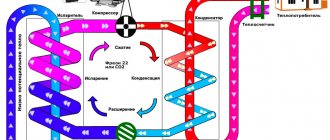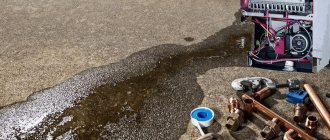Types of Kermi brand convectors
Kermi convection water heaters are produced in two main types: built-in and floor-mounted.
A special group consists of non-standard designs. The devices are united by a single operating principle. The heat exchange part receives hot water from the heating system. The heated metal transfers heat to the air. The warm air flow rises, giving way to cold masses.
The convection process promotes rapid heating of the room volume.
Steel floor
Floor-mounted heating devices are installed along wide-format windows. By generating a flow of thermal radiation, they create a screen against the penetration of cold air into the room.
A heat exchanger is located inside the galvanized steel casing. The device consists of metal pipes with fins.
Using pipes, the device is connected to the pipes of the heating system. Kermi floor convectors are made with side or bottom connections.
Floor recessed
Hidden installation convectors are distinguished by the fact that they are located flush with the floor. To do this, a recess is made in the floor covering. The niche houses the device housing with active equipment. The top of the device is covered with a decorative grille.
The devices can operate on the principle of natural or forced convection. In the second case, a fan is added to the kit to speed up the air mixing process.
Kermi built-in convectors heat the air evenly throughout the entire height of the room. There are no drafts and cold air does not accumulate under the device.
Special versions
For rooms with non-standard configurations, convectors of special shapes are manufactured to order.
For example:
- corner (for location at the junction of walls);
- radius (for rounded shapes);
- complex shape (with several bends, with a recess for a column).
To order special-design convection devices, the necessary measurements and calculations are first made.
Kinds
Buyers of Kermi radiators face a difficult choice task. The large range of indicators forces us to study the technical characteristics in more detail. The designs and size range of devices are different. Specific data is also related to the design of the units. For example, heating radiators on sale range from 40 cm to 3 meters in length, the height of the radiator is from 30 to 90 cm.
Tubular, panel, and finned options are common.
Panel steel appliances from this company come with one, two and three panels. The three-layer design is considered the most powerful. Devices are also divided into types, which are related to the number of panels. The table includes 10 to 33 product types. For example, the first is the 10th type, which includes one such part, the 11th type includes an addition in the form of ribbing, the 12th type - thin batteries 6.5 cm wide, the 22nd type - two panels and double ribbing. Type 30 and above include batteries with three rows and triple fins.
Batteries with a corrugated surface belong to the Profil category, and smooth radiators with a flat front panel are called Plan. In the group of smooth devices there are also various options that differ in characteristics and markings.
Plan-V options are designated FKO - these are radiators with a lower supply option, known to customers in the following three types:
- left-handed;
- right-sided;
- centered.
Plan-K models marked FKV are distinguished by lateral inlet.
The association includes suitable options for replacing old cast iron radiators with a distance between the axes from 50 to 90 cm. If the pipes are in normal condition, replacing them with these devices does not require their digestion.
Another unusual option is Verteo Plan.
This vertical type product is needed in cases where installing a horizontal version of the required power is impossible.
FTV radiators are newer models that replaced the FKV variants. The models are equipped with a bottom connection option and allow the installation of a hidden pipe system. Communications for these products can be placed under the floor base. The radiators are distinguished by a two-layer varnish coating. Treatment inside and outside protects products from corrosive destruction. Line radiators from Kermi have an excellent external design.
The line includes a wide range of mounting sizes. Radiators of this type are easy to install. These radiators successfully combine excellent design and functionality of the devices. The models are characterized by high performance. The heat transfer of steel radiators mounted in the wall is comparable to bimetallic options. Replacing energy-consuming options with cost-effective batteries is easy and simple. It is enough to make the necessary calculations.
What to do after the calculation
After calculating the power of heating radiators for all rooms, it will be necessary to select a pipeline by diameter and taps. Number of radiators, length of pipes, number of taps for radiators. Calculate the volume of the entire system and select a suitable boiler for it.
For humans, home is often associated with warmth and comfort.
And in order for the house to be warm, it is necessary to pay due attention to its heating system. Modern manufacturers use the latest technologies to produce various elements of heating systems
However, without proper planning of such a system, these technologies may be useless for certain premises.
Steel panel radiators are a competitor to conventional sectional heating devices. They are attractive because, compared to all sectional models, with smaller dimensions, they have a higher heat transfer coefficient. They consist of panels in which the coolant moves along formed passages. There can be several panels: one, two or three. The second component is corrugated metal plates, which are called fins. It is due to these plates that a high level of heat transfer from these devices is achieved.
To obtain different thermal power, panels and fins are combined in several options. Each option has different power. To choose the right size and power you need to know what each of them is. By structure, steel panel batteries are of the following types:
- Type 33 - three-panel. The most powerful class, but also the largest. It has three panels to which three fin plates are connected (that’s why it’s designated 33).
- Type 22 - two-panel with two fin plates.
- Type 21. Two panels and between them one plate with corrugated metal. These heating devices, with equal dimensions, have less power compared to type 22.
- Type 11. Single-panel steel radiators with one fin plate. They have even less thermal power, but also less weight and dimensions.
- Type 10. This type has only one coolant panel. These are the most low-power and lightest models.
All these types can have different heights and lengths. Obviously, the power of panel radiators depends on both the type and dimensions. Since it is impossible to calculate this parameter independently, each manufacturer compiles tables in which it records test results. Based on these tables, radiators are selected for each room.
Manufacturer's description
Heating radiator Kermi
The German company was founded in 1960. The main profile of its activity is the production of panel-type heaters and modern shower stalls. A distinctive feature of Kermi heating radiators is the presence of two connection methods, as well as various design options. In addition to standard steel structures, the manufacturer offers relatively inexpensive bimetallic products.
A characteristic feature of German radiators is a high level of heat transfer, superior to that of models from other well-known manufacturers. It can be achieved due to the high efficiency of heat exchange processes occurring inside the heating system. Kermi heating radiators are an ideal option for installation in autonomous lines with low operating pressure (in a cottage or country house, for example).
Models Kermi FTV 22
Equipment in this series can be installed even in the living room, and the bottom type of connection will ensure that all pipes and wires are hidden under the floor. Good thermal conductivity is ensured by two heating panels and two convection elements (in previous versions there was only one element).
Characteristics
Models with bottom connection Kermi 22 are characterized by:
- material – carbon steel 1.25 mm thick;
- high heat transfer;
- not bulky dimensions;
- corrugated surface provides better heat distribution;
- pressure – 10 bar, length – from 400 mm, height – from 300 mm, depth – from 100 mm.
Price
This type of heater is designed for heating houses with spacious rooms. The presence of two convection elements allows you to make the heating system work more efficiently and quickly. The approximate cost of radiators of the FTV 22 type can be as follows:
- a 400x2000 mm model with a heat output of 3210 W and a capacity of 9 liters will cost 9,000 rubles;
- radiator 600x2300 mm with heat output 5173 W, capacity 14.49 l - 11,000 rubles;
- a heater 900x1200 mm with a heat output of 3797 W and a capacity of 10.8 liters costs 9800 rubles.
We recommend studying - Get in the mood for a loft: how to create a loft mood in an ordinary apartment
The latest model is considered the most popular - it performs the maximum number of functions.
Advantages of radiators with bottom connections
All Kermi models have a modern and compact appearance. In addition to aesthetic properties, there are other important advantages:
- the presence of a unit that turns off the radiator in one room and does not affect other rooms in the house;
- bottom connection is used in panel and tubular models;
- easy installation and ease of operation of the product, the ability to hide pipes and wires under the floor;
- such radiators can be installed in any heating system, varying capacities and designs;
- the presence of a thermostat and thermostatic valve.
https://youtube.com/watch?v=otVXrHAX2EE
Types of radiators
produces two types of batteries: panel and tubular.
Panel
Panel-type radiators are equipped with protective linings made of thin steel that cover the heating element. The continuous design allows you to increase the heat capacity compared to the sectional one. The device panel can be smooth or ribbed.
Prices for panel heating radiators Purmo
panel heating radiators Purmo
Tubular
Tubular-type batteries consist of separate sections fastened together. They have a sophisticated design. Tubular structures are easy to clean. The main disadvantage: heat transfer is 15–20% lower than that of panel ones, with the same dimensions.
Peculiarities
The German company Kermi was founded in 1960. The main type of products produced are steel panel radiators, although the manufacturer is also known for shower cabins. However, it is German radiators that have gained wide popularity not only in Germany, but throughout the world. Russian buyers also liked the appearance of German batteries
An important component of success was the quality of products.
The features of the radiators include two types of connection, as well as three different metal thicknesses.
In addition to steel products, bimetallic options are available to customers. Russian consumers especially liked products intended for installation in individual houses and cottages. The appearance of the devices is refined, noble and elegant. The units are not cheap, but consumers note the cost recovery, as well as a high degree of comfort.
The operating principle of any radiators is based on the coolant circulating inside the device. The liquid entering the radiator tends to slow down its movement from device to device and also cool down. As a result, less heat is transferred into the room. The main feature of German radiators is their increased heat output characteristics. The heat transfer from the front surface of the installed batteries is quite decent. Therefore, Kermi radiators are ideal for autonomous heating systems with low operating pressure.
The company offers batteries in various sizes.
Mostly white models are on sale. According to the manufacturer, the powder coating of products is environmentally friendly. It is also claimed that this special coating allows for better temperature retention of devices. Decorative models found on sale differ from the main line in color and design features.
The main type of products manufactured by Kermi are panel radiators, consisting of steel plates connected in pairs. The coolant in such radiators moves through channels extruded by stamping. Usually there are several channels for circulating fluid. One of them is located at the top, and the other is at the bottom. There are several paired plates assembled in a steel product.
To increase efficiency, some models contain convective fins - these are corrugated steel sheets that are small in thickness and are usually welded behind the front panel. Externally, this usually does not change anything, but the sides and top of the product are decorated. Some Kermi batteries have a different media supply method. The Therm-X2 technology is considered consistent and renowned. In practice, hot liquid is supplied first to the front part, then to the subsequent ones. As a result, the hottest part is the part facing the rooms.
Greater heat consumption occurs in the room.
There is much less other heat consumption with this connection. In practice, Kermi series-type batteries heat the room faster than other types of devices. The devices showed a special heating quality when pumps and collectors were connected to the system. The company installs control valves on its devices. The new product allows you to optimally balance a stable temperature in all rooms. Basically, steel radiators from other manufacturers are supplied with thermostats, but the thermal head must be purchased separately. Kermi radiators add comfort to individual heating systems. The system consumes only a adjusted amount of fuel, which significantly reduces costs.
In addition to the sequential version, Kermi batteries have the possibility of a side and bottom version. The lower supply can be left or right, and it can also be in the center. Therefore, the installation of heating pipes can be done as conveniently as possible, without taking into account the features of the heating device. Installation of devices can be carried out after finishing is completed, it is only advisable to secure the brackets on the wall in advance. It is worth considering in more detail the technical characteristics of the main types of radiators produced by the company.
Adviсe
Reviews of Kermi batteries are mostly positive. High-quality raw materials and high-quality assembly make themselves felt. Kermi radiators are rated by users as correct and durable. At the same time, many consumers, when purchasing these products, largely rely on the recommendations of sales consultants. Russian consumers still know little about modern batteries. Those who have already replaced old analogues note the good performance of radiators with less filling of the system. As users note, consultants most often recommend type 22 radiators, which may be why they are so popular.
Few people know that, in addition to panel batteries, Kermi also produces designer models of various designs. If you want to buy something unusual but functional for your apartment, these are Kermi radiators with beautiful interweaving pipes in various designs. The models are highly durable, as the pipes are joined by laser. These radiators are of water type and also electric. The most productive units can heat a room up to 20 square meters. m.
It is worth noting the Kermi Ideos line. The shape of the ldeos pipes is refined and refined, reminiscent of stars. The assembly is of high quality.
Another original representative of the brand is Kermi Fedon. The model is not only original, but also easy to use. Particular comfort lies in the conveniently located temperature regulator. All connection points of parts in this model are hidden from view.
Kermi Credo Swing models are distinguished by an original connection of pipes with a triangular cross-section. Models in this line are characterized by smoothness. A heated towel rail is available to customers as an additional device.
The Kredo Duo model is similar to its previous brother, but is characterized by strict lines. The line of these radiators is famous for its improved heat transfer.
Credo Half are functional, beautiful products. The pipes in the radiator are transverse and harmonize perfectly with the screen block. Special spacers add stability to the product.
Credo Twist are presented with oval-shaped pipes. As a result, the battery itself looks beautifully curved. The size of the pipes is the smallest, but this adds a holistic look to the structure.
Karotherm is a model with perfect symmetry of numerous squares. Small squares are enclosed in a single outline.
Jive is the opposite of the previous option. The model seems ephemeral and light, but nevertheless transmits enough heat to warm the room. The Icaro model is similar in appearance to the previous version. This battery is also asymmetrical, light, airy.
The products from the Dekor line are somewhat similar to the usual finned radiators. The pipes in the models are large with a round cross-section. A distinctive feature is the built-in power control system.
The line is distinguished by varieties S, D. The latter variety is especially similar to our old radiator batteries, however, it has a more refined appearance.
Experts say that this particular line of products is ideal when replacing cast iron radiators with new modern models. When replacing, no additional adapters or switches are required. New radiators of the Decor D series are simply installed into the system. If you need to clarify more detailed characteristics of the products you like, it is best to study them according to the passport indicators.
To learn how to install Kermi radiators, see the following video.
Determining the power of radiators based on the volume of the room
According to building codes, one cubic meter of room requires the following heat transfer:
- in panel buildings – 0.041 kW;
- in brick - 0.034 kW.
For example, let’s take a room in a brick building. Ceiling height – 2.7 m. Walls 3 and 5 m long. Room volume – 40.5 m3. To obtain the average power indicator, it is necessary to multiply the volume by a factor of 0.034 kW. The result of the product (40.5x0.034) is 1.377 kW (1377 W).
But this result is valid only for the average climate zone and without taking into account the correction depending on the number of external walls and windows. The illustration shows the dependence of the coefficients on the average winter temperature.
Some coefficients by which you need to multiply the average required heat transfer, depending on the number of external walls and windows, as well as taking into account the location of window openings:
- 1 external wall – 1.1;
- 2 external walls and 1 window – 1.2;
- 2 external walls and 2 windows – 1.3;
- the windows “look” towards the north – 1.1.
If radiators are supposed to be installed in a niche, then for Kermi batteries the power calculation is adjusted taking into account a factor of 0.5. If the thermal structure is covered with a perforated panel, the average value should be multiplied by 1.15.
For example, in our conditional room with a volume of 40.5 there are two walls facing the street. At the same time, the average temperature in winter is -30. In this case, we multiply the resulting heat transfer by the required coefficients - 1377x1.2x1.5 = 2478.6 W. The rounded result is 2480 W.
This number is relatively accurate, but the matter is not limited to the mentioned coefficients. When making thermal calculations, specialists take into account what material the walls are made of, the characteristics of the surrounding rooms, etc. But, provided that the average indicators are averaged, this number can be used. To determine the type of batteries, the power table of Kermi radiators is used.
Don't overdo it
It should also be noted that 14-15 sections for one radiator is the maximum.
Installing radiators of 20 or more sections is ineffective. In this case, you should split the number of sections in half and install 2 radiators of 10 sections each. For example, place 1 radiator near the window, and the other near the entrance to the room or on the opposite wall. In general, it's up to you. It's the same story with steel radiators. If the room is large enough and the radiator is too large, it is better to install two smaller ones, but with the same total power.
If there are 2 or more windows in a room of the same volume, then a good solution would be to install a radiator under each window. In the case of sectional radiators, everything is quite simple.
14/2=7 sections under each window for a room of the same volume
But, since such radiators are usually sold in 10 sections, it is better to take an even number, for example 8. A supply of 1 section will not be superfluous in case of severe frosts. This will not change the power much, but the heating inertia of the radiators will decrease. This can be useful if cold air often enters the room. For example, if this is an office space that clients often enter. In such cases, radiators will heat the air a little faster.
Installation
Installation of Kermi radiators is not difficult, but each job has its own nuances. For example, when there is no need to replace pipes, adapters will help solve the problem with different diameters of communications and radiator outlets. The instructions will help with more competent installation. It is convenient to study the connection nuances using the diagram supplied with the product. For example, it indicates an important point regarding the connection of the separation plug, which ensures the functioning of Therm-x2 technology.
We advise you to study - How to choose a construction stapler without making a single mistake
The installation process also involves two types of connections, which means the installation schemes can be bottom and side.
It is important to choose the optimal location depending on the type of installation; the manufacturer’s recommendations are as follows:
- 100–120 mm from the floor covering;
- 80–100 mm from the window sill.
In both cases, this distance will provide the most efficient heat transfer. If the radiator is located 20–50 mm from the vertical, then there will be no energy loss for gentle heating of this area.
A distinctive feature of the company is that the batteries are supplied in stores with all the necessary components for installation. The heating device is presented in a branded box. The packaging may not be removed during installation, thereby leaving the device intact.
The standard Kermi kit includes the following items:
- loops;
- corner clamps, console;
- grill top;
- covers and damping sides;
- Mayevsky crane;
- thermostatic tap;
- instructions for installation and use.
The stages of attaching radiators can be presented in the following order:
choosing a location for the device taking into account optimal heat transfer; marking under hooks; fastening of auxiliary fittings; fixing the radiator on hooks; device alignment; connecting the device according to the diagram to the pipes; pressure testing - testing a system that can be hydraulic (water) or pneumatic (air); commissioning work, during which it is important to check the tightness.
13.09.2017 06:48
The required thermal output of Kermi radiators depends on:
- room area;
- room volume;
- heat loss of the room;
- characteristics of the heating system.
Comparison of characteristics of leading manufacturers
Bimetallic batteries are offered by many manufacturers, both Russian and foreign. There is no point in listing the characteristics of products from all brands here, especially since they are largely similar. For example, the interaxial dimensions of bimetallic radiators range from 200 to 800 mm, the most popular of them are 350 and 500 mm. The total height of such products is approximately 420 and 580 mm, respectively. The depth and width of each section is manufactured in the range from 80 x 80 mm to 100 x 85 mm.
There are heating devices with a center distance of 200 and 800 mm, the former are designed for installation under a low window sill or stained glass window and often have a floor mount and a bottom connection. The 800 mm standard size looks good near blank walls.
Let's look at the performance characteristics of heating radiators using the example of leading Italian and Russian brands: GLOBAL, RADENA and RIFAR. We will summarize all the data in a table.
Having carried out an express analysis of the given characteristics, we can say that Italian products place maximum emphasis on the reliability and durability of products, even at the expense of the available thermal power. This can be seen in the increased weight and high operating pressure threshold of the batteries. Although the increase in weight is insignificant in terms of complicating the installation of radiators. At the same time, the Russian manufacturer RIFAR separately offers the MONOLIT model, operating at operating pressures up to 100 Bar. This figure was achieved due to a monolithic design, where the sections of the bimetallic battery are inseparable from each other and there are no threaded connections.
Connection features
Radiator installation standards
Installing Kermi radiators is not at all difficult, especially if you take into account all the nuances of the upcoming work in advance
If you do not plan to change the existing wiring diagram, it is important to provide for the possibility of connecting it to the inlet and outlet pipes of the battery. With different standard sizes of pipes laid in the apartment and working openings of radiators, special adapters will be required
To identify the installation features of a new heating system, it is recommended to immediately read the installation instructions. After all the nuances have been taken into account, you can proceed directly to the procedure for connecting radiators. At the same time, we should not forget that there are two connection options, according to which it can be bottom and side. Each of these methods has its own characteristics.
Before installing Kermi radiators with bottom connections, for example, it is important to decide on their installation location, selected taking into account the following requirements:
- the distance from the floor should not be less than 100-120 mm;
- location relative to the window sill - no closer than 80-100 mm.
Compliance with these requirements guarantees the convenience of pipe installation and also ensures maximum heat transfer.
When purchasing radiators, consumers receive brackets, Mayevsky valves, plugs and adapters in the kit.
Another feature of these products is that they are supplied with all the necessary components for installation, which includes:
- mounting brackets (hooks);
- corner clamps;
- upper protective grille;
- covers and sides in the form of plugs.
The same kit includes thermostat and Mayevsky bleed valves, but not for all types of supplied products.
The procedure for installing and connecting radiators with bottom connections:
- Marking of the mounting points for the brackets is applied at the selected location.
- They are securely attached using the hardware supplied with the kit.
- Upon completion of this operation, the radiator is hung on hooks and leveled.
- After this, it is connected to the pipe system (including the return).
The last procedure is carried out in accordance with the diagram available in the instructions.
Power calculation
One of the options for calculating radiator power involves the use of a comparative method, when a typical cast-iron 12-section battery is taken as a basis.
From the studies conducted, it is known that with such dimensions it provides a heat transfer of about 1444 W. The capacity of the internal volume of the cast iron sample filled with coolant is 13 liters.
From the Kermi battery passport it is easy to find out that the heat transfer from a typical single-section unit code 10 is about 2100 W (with a working volume of 6.3 liters). Using this data when replacing cast iron batteries with new models, you can be sure that their heat transfer will be no worse, and even slightly higher.
To correctly determine the required power and radiator connection diagram, a tabular calculation option is used. To implement it, the following additional data will be required:
- the amount of heat loss in the apartment;
- liquid carrier parameters;
- expected room average temperature.
When choosing, the dimensions of the radiator are also taken into account, after which appropriate adjustments are made to the selection algorithm. The required value of thermal output is determined from a summary table provided by the manufacturer of a specific radiator from the popular Kermi line. The required model is located in the corresponding column, opposite which the power value suitable for it is indicated. Experts advise taking this indicator with a small margin, which guarantees obtaining the required result.
After all parameters are taken into account, the user will be able to more accurately determine the model suitable for specific operating conditions.
Advantages and disadvantages of Kermi batteries
German Kermi heating radiators have a lot of advantages and a minimum of disadvantages - this is typical for many types of products made in Germany. First, let's describe the key advantages:
Kermi Therm-x2 technology will help save your money thanks to the special circulation of coolant in the radiator.
- High efficiency due to the therm-x2 technology used – ensures reduced heating costs;
- High-quality steel base – ensures long service life;
- Resistance to pressure up to 10 atmospheres - test pressure for many models is 13-14 atmospheres;
- An abundance of models - for any interior;
- Availability of built-in thermostats (typical for some models);
- Fast heating of rooms is ensured by therm-x2 technology.
As for the disadvantages, there are very few of them:
- Lack of resistance to water hammer - steel cannot withstand strong overloads;
- Somewhat high prices - you have to pay for the quality of German products.
Thus, Kermi heating batteries will be an excellent solution for heating residential premises.
Generalization on the topic
The described radiators have unique technical characteristics. Innovative heating technology made it possible to form them. The principle of its operation is significantly different from that of conventional steel radiators. The difference lies in the design features of the heating equipment described and in the supply of coolant. In ordinary steel batteries, it flows evenly into all radiator tubes. Here it is first supplied to the front panel, and then goes through a convector located along the rear panel. This scheme made it possible to increase the efficiency of the heating device by 11%.
We advise you to study - Which laser level is better to buy - a comparison of different types and a review of the best models
Read further:
Gas boiler Navien - technical characteristics, design features and model range
Danish circulation pumps Grundfos - technical characteristics and design features
Technical characteristics of aluminum radiators and features of their design
Kermi steel radiators - low inertia, high-quality heating
Bimetallic heating radiators rifar - technical features and advantageous characteristics
Features of operation
Any radiators require cleaning from dust two to three times a season: dust greatly reduces heat transfer. In addition, in currents of warm air it rises to the top and can cause allergy attacks. But some models (except type 10 and hygienic) panel radiators are closed on all sides: there are side covers and a grille at the top. There are no latches or other devices visible from the outside.
There is only a plastic “Kermi” logo on the side panel. So he serves as the key. Pull the left edge of the logo towards you and turn it down a little. A hole opens. But the logo still needs to be turned counterclockwise until it comes off (it screws onto a plastic threaded pin, so don’t pull too hard). But the left edge needs to be pulled back all the time - there is a locking edge there that can scratch the paint. After you remove the logo, you can pull the side plate down so that it is removed from the latches. If the model has a valve, remove the left panel first; there is a valve on the right and is in the way. After removing the sides, nothing holds the lid. Can be cleaned.
Assembly proceeds in the reverse order: install the top grille, then the side panels (first right, then left), and then the logos.
Kermi radiators are found in approximately 80-90% of stores selling heating equipment. It’s easy to verify this - go to any store and check their availability, in the vast majority of cases the answer will be positive. Radiators from this German manufacturer are famous for their quality and durability, and their variety allows you to heat any type of room. Therefore, we decided to devote a separate review to Kermi. In it we will tell you:
- About the technologies used in production;
- About the technical characteristics of radiators;
- About the advantages and disadvantages of Kermi products;
- About the most popular models.
Finally, we will publish user reviews.
Reviews
“Kermi are one of the most expensive, but also the most reliable radiators. They are in my apartment. To prevent rust after the end of the heating season, I close the taps and the water remains inside. And further. These are the whitest radiators I’ve ever seen.”
Cherkasy
“They say Kermi has the most reliable panel radiators. This is probably so, because they have considerable weight. Only worn by two people. It’s only been there for a season so far, but there are no complaints.”
Nikolai. Eagle
“Very reliable. My Kermi's have been standing for 7 years now. The appearance hasn't changed one bit. What they were is what they are. They did not swell in any place, nor did they rust in any place. They are located in the house, so they are easy to use. It is problematic to clean the inside: neither a rag, nor a brush, nor a steam generator can completely clean it. You have to struggle with the wire, at the end of which there is a rag attached. But this is a disease of all panel radiators, not just Kermi.”
Alex, Tiraspol
Panel steel heating radiators KERMI ThermX2
Made according to all European standards, they have a wavy profile surface and are notable for their low price. They are only suitable for closed heating systems. The small volume of hot water coupled with high heat output makes these devices most suitable for autonomous heating. Moreover, it is better to use them in systems where the coolant is not excessively hot.
These radiators are made using the latest patented X2 technology, which significantly increases the efficiency of heating devices. By doubling the radiation of the infrared spectrum, this technology made radiators very comfortable. Heating time has accelerated by about a quarter, and savings have increased by 11%. The meaning of the X2 principle is that the front panel heats up first, and only after that the back panel. For more information about this, see the video below.
Video: Technical features of Kermi steel panel radiators
After joining the panels into a body, the finished product is first thoroughly degreased, then it is phosphated. The final finishing is done using electrostatic painting. The top layer of paint is processed at a temperature of 180 degrees. This makes it durable. The shiny coating gives the batteries an elegant look.
The radiator has screen grilles on the top and sides. They can achieve a significant increase in heat transfer efficiency - by 60%. The set includes 4 pads designed for attaching equipment.
There are 2 lines of Kermi panel radiators, which differ in the location of connection to the heating network. Radiators from the Kermi ThermX2 Profil-K (FKO) line are connected to the side. And devices such as Kermi ThermX2 Profil-V (FKV or FTV) are designed for connection from below.
Side-connected Kermi ThermX2 Profil-K
These radiators are equipped with convectors, and their panels are made of two profiled steel sheets connected by welding. There are screens on the sides, and an overhead grill-type grill on top. Radiators with a side connection type are marked with the letter combination FKO. To connect to the system on the sides, the Kermi Profil-K FKO device has four pipes with internal threads (1/2″ diameter). The radiator can be connected to the pipes from any side.
Technical characteristics of heating radiators Kermi ThermX2 FKO:
- Connecting thread: 4 x G1/2” (internal)
- Height: 300, 400, 500, 600, 900
- Center distance: total height minus 50 mm
- Length: from 400mm to 3000mm
- Depth: type 10 and 11 - 61mm, type 12 - 64mm, type 22 - 100mm, type 33 - 155mm
- Working pressure – 10 atm. (1.0 MPa)
- Crimping pressure – 13 atm. (1.3 MPa)
- Max. coolant temperature: 110°C
- Operating temperature – 95°
Specifications
*Design: p>
Type 21: double row with convector
Type 33: three-row with 3 convectors
Type 21: 100 mm
Type 33: 155 mm
Power: shown in tables
*See pictures
**Other possible overall dimensions (length and height) are indicated in tables em>
| Length, mm | Type 10 | Type 11 | ||||||
| Height | Height | |||||||
| 400 | 500 | 600 | 900 | 400 | 500 | 600 | 900 | |
| 400 | 228/96 | 278/116 | 329/137 | 485/200 | 379/159 | 459/192 | 538/223 | 770/315 |
| 500 | 286/120 | 348/145 | 411/172 | 606/250 | 474/199 | 574/239 | 673/279 | 963/394 |
| 600 | 343/144 | 418/174 | 493/206 | 727/299 | 568/239 | 688/287 | 808/335 | 1156/473 |
| 700 | 401/168 | 487/203 | 575/240 | 848/349 | 663/279 | 803/335 | 942/391 | 1348/551 |
| 800 | 458/192 | 557/232 | 658/275 | 970/399 | 758/319 | 918/383 | 1077/447 | 1541/630 |
| 900 | 515/216 | 626/262 | 740/309 | 1091/449 | 852/358 | 1032/431 | 1211/502 | 1733/709 |
| 1000 | 572/240 | 696/291 | 822/343 | 1212/499 | 947/398 | 1147/479 | 1346/558 | 1926/788 |
| 1200 | 686/288 | 835/349 | 986/412 | 1454/599 | 1136/478 | 1376/575 | 1615/670 | 2311/945 |
| 1400 | 801/336 | 974/407 | 1151/481 | 1697/699 | 1326/557 | 1606/670 | 1884/781 | 2696/1103 |
| 1600 | 915/384 | 1114/465 | 1315/549 | 1939/799 | 1515/637 | 1835/766 | 2154/893 | 3082/1260 |
| 1800 | 1030/432 | 1253/523 | 1480/618 | 2182/898 | 1705/717 | 2065/862 | 2423/1005 | 3467/1418 |
| 2000 | 1144/480 | 1392/581 | 1644/686 | 2424/998 | 1894/796 | 2294/958 | 2692/1116 | 3852/1576 |
| 2300 | 1316/552 | 1601/669 | 1891/789 | 2788/1148 | 2178/915 | 2638/1102 | 3096/1284 | 4430/1812 |
| 2600 | 1487/624 | 1810/757 | 2137/892 | 3151/1297 | 2462/1035 | 2982/1245 | 3500/1451 | 5008/2049 |
| 3000 | 1716/720 | 2088/873 | 2466/1030 | 3636/1497 | 2841/1194 | 3441/1437 | 4038/1674 | 5778/2364 |
| Length, mm | Type 12 | Type 21 | ||||
| Height | Height | |||||
| 500 | 600 | 900 | 500 | 600 | 900 | |
| 400 | 571/238 | 666/277 | 926/386 | 639/263 | 745/305 | 1045/424 |
| 500 | 714/298 | 832/347 | 1157/482 | 799/329 | 931/381 | 1307/531 |
| 600 | 856/357 | 998/416 | 1388/578 | 958/395 | 1117/457 | 1568/637 |
| 700 | 999/417 | 1165/485 | 1620/675 | 1118/460 | 1303/533 | 1829/743 |
| 800 | 1142/476 | 1331/554 | 1851/771 | 1278/526 | 1490/609 | 2090/849 |
| 900 | 1284/536 | 1498/624 | 2083/868 | 1437/592 | 1676/685 | 2352/955 |
| 1000 | 1427/595 | 1664/693 | 2314/964 | 1597/658 | 1862/761 | 2613/1061 |
| 1200 | 1712/714 | 1997/832 | 2777/1157 | 1916/789 | 2234/914 | 3136/1273 |
| 1400 | 1998/833 | 2330/970 | 3240/1350 | 2236/921 | 2607/1066 | 3658/1486 |
| 1600 | 2283/952 | 2660/1109 | 3702/1542 | 2555/1052 | 2979/1218 | 4181/1698 |
| 1800 | 2569/1071 | 2995/1247 | 4162/1735 | 2875/1184 | 3352/1371 | 4703/1910 |
| 2000 | 2854/1190 | 3328/1386 | 4628/1928 | 3194/1315 | 3724/1523 | 5226/2122 |
| 2300 | 3282/1369 | 3827/1594 | 5322/2217 | 3673/1513 | 4823/1750 | 6010/2440 |
| 2600 | 3710/1547 | 4326/1802 | 6016/2506 | 4152/1711 | 4841/1979 | 6794/2759 |
| 3000 | 4281/1785 | 4992/2079 | 6942/2892 | 4791/1974 | 5586/2283 | 7839/3183 |
| Length mm | Type 22 | Type 33 | ||||||||
| Height | Height | |||||||||
| 300 | 400 | 500 | 600 | 900 | 300 | 400 | 500 | 600 | 900 | |
| 400 | 510/213 | 642/266 | 772/318 | 900/368 | 1266/503 | 735/298 | 926/373 | 1109/444 | 1286/511 | 1756/694 |
| 500 | 638/267 | 803/333 | 965/397 | 1125/460 | 1582/629 | 919/373 | 1157/467 | 1387/555 | 1607/639 | 2196/867 |
| 600 | 766/320 | 963/399 | 1158/477 | 1349/552 | 1898/755 | 1102/448 | 1388/560 | 1664/666 | 1928/767 | 2635/1041 |
| 700 | 893/373 | 1124/466 | 1351/556 | 1574/644 | 2215/881 | 1286/522 | 1620/653 | 1941/777 | 2250/895 | 3074/1214 |
| 800 p> | 1020/426 | 1284/532 | 1544/636 | 1799/736 | 2531/1007 | 1470/597 | 1851/747 | 2218/889 | 2571/1023 | 3513/1388 |
| 900 | 1148/480 | 1445/599 | 1737/715 | 2024/828 | 2848/1133 | 1653/671 | 2083/840 | 2496/1000 | 2893/1151 | 3952/1561 |
| 1000 | 1276/533 | 1605/666 | 1930/795 | 2249/920 | 3164/1259 | 1837/746 | 2314/933 | 2773/1111 | 3214/1278 | 4391/1735 |
| 1200 | 1531/639 | 1926/799 | 2316/954 | 2699/1104 | 3797/1510 | 2204/895 | 2777/1120 | 3328/1333 | 3857/1534 | 5269/2081 |
| 1400 | 1786/746 | 2247/932 | 2702/1113 | 3149/ 1288 | 4430/1762 | 2572/1044 | 3240/1307 | 3882/1555 | 4500/1790 | 6147/2428 |
| 1600 | 2040/852 | 2568/1065 | 3088/1272 | 3598/1472 | 5062/2014 | 2939/1194 | 3702/1493 | 4437/1777 | 5142/2045 | 7026/2776 |
| 1800 | 2297/959 | 2889/1198 | 3474/1431 | 4048/1656 | 5695/2266 | 3307/1343 | 4165/1680 | 4991/1999 | 5785/2301 | 7904/3123 |
| 2000 | 2552/1066 | 3210/1331 | 3860/1590 | 4498/1839 | 6328/2518 | 3674/1492 | 4628/1867 | 5546/2221 | 6428/2557 | 8782/3470 |
| 2300 | 2935/1226 | 3692/1531 | 4439/1728 | 5173/2115 | 7277/2896 | 4225/1716 | 5322/2147 | 6378/2555 | 7392/2940 | 10099/3991 |
| 2600 | 3318/1385 | 4173/1730 | 5018/2066 | 5847/2391 | 8226/3273 | 4776/1940 | 6016/2612 | 7210/2889 | 8356/3323 | 11417/4511 |
| 3000 | 3828/1598 td> | 4815/1997 | 5790/2384 | 6747/2759 | 9492/3777 | 5511/2238 | 6942/2799 | 8319/3333 | 9642/3834 | 13173/5205 |
Interpretation of the table data: 2935/1226, where 2935 is the thermal power in W at a coolant temperature of 90/70 ° C; 1226 - thermal power in W at a coolant temperature of 55/45°C. The room temperature is assumed to be 20°C.
